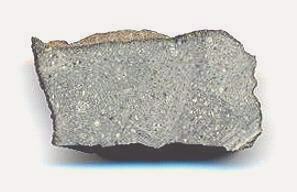R5, rumurutiiteMember of a rare group of chondrites, formerly named the Carlisle Lakes group, after a meteorite found in Australia in 1977. It is now named for the type specimen Rumuruti that fell in Kenya, Africa, in 1934. Rumuruti is the only witnessed fall of this group and only one small

Purchased October 2002
coordinates not recorded A very fresh 710 g stone with black fusion crustMelted exterior of a meteorite that forms when it passes through Earth’s atmosphere. Friction with the air will raise a meteorite’s surface temperature upwards of 4800 K (8180 °F) and will melt (ablate) the surface minerals and flow backwards over the surface as shown in the Lafayette meteorite photograph below. Click on Term to Read More was found in Morocco or Algeria. It was subsequently purchased in Denver from a Moroccan dealer by D. Gregory. Analysis and classification was completed at the Department of Earth and Space Sciences, University of Washington (A. Irving and S. Kuehner), and this meteoriteWork in progress. A solid natural object reaching a planet’s surface from interplanetary space. Solid portion of a meteoroid that survives its fall to Earth, or some other body. Meteorites are classified as stony meteorites, iron meteorites, and stony-iron meteorites. These groups are further divided according to their mineralogy and Click on Term to Read More, named NWA 1668, was determined to be an R5 genomict brecciaWork in Progress ... A rock that is a mechanical mixture of different minerals and/or rock fragments (clasts). A breccia may also be distinguished by the origin of its clasts: (monomict breccia: monogenetic or monolithologic, and polymict breccia: polygenetic or polylithologic). The proportions of these fragments within the unbrecciated material Click on Term to Read More.
As is typical for R
chondritesChondrites are the most common meteorites accounting for ~84% of falls. Chondrites are comprised mostly of Fe- and Mg-bearing silicate minerals (found in both chondrules and fine grained matrix), reduced Fe/Ni metal (found in various states like large blebs, small grains and/or even chondrule rims), and various refractory inclusions (such Click on Term to Read More,
chondrulesRoughly spherical aggregate of coarse crystals formed from the rapid cooling and solidification of a melt at ~1400 ° C. Large numbers of chondrules are found in all chondrites except for the CI group of carbonaceous chondrites. Chondrules are typically 0.5-2 mm in diameter and are usually composed of olivine Click on Term to Read More are more sparsely distributed than in other chondrites. They have an average diameter of ~0.3 mm, which is larger than those in CO3 chondrites and smaller than those in ordinary chondrites (Imae and Zolensky, 2003), a size consistent with what is expected to occur at large
heliocentricCentered around a sun. Our own Solar System is centered around the Sun so that all planets such as Earth orbit around the Sun. Note that 25% of Americans incorrectly believe the Sun revolves around the Earth. Click on Term to Read More distances. With respect to mineralogy, NWA 1668 is primarily composed of
olivineGroup of silicate minerals, (Mg,Fe)2SiO4, with the compositional endpoints of forsterite (Mg2SiO4) and fayalite (Fe2SiO4). Olivine is commonly found in all chondrites within both the matrix and chondrules, achondrites including most primitive achondrites and some evolved achondrites, in pallasites as large yellow-green crystals (brown when terrestrialized), in the silicate portion Click on Term to Read More (Fa38.9), clinopyroxene,
orthopyroxeneOrthorhombic, low-Ca pyroxene common in chondrites. Its compositional range runs from all Mg-rich enstatite, MgSiO3 to Fe-rich ferrosilite, FeSiO3. These end-members form an almost complete solid solution where Mg2+ substitutes for Fe2+ up to about 90 mol. % and Ca substitutes no more than ~5 mol. % (higher Ca2+ contents occur Click on Term to Read More,
troiliteBrass colored non-magnetic mineral of iron sulfide, FeS, found in a variety of meteorites. Click on Term to Read More, and Ti-chromite, along with minor sodic
plagioclaseAlso referred to as the plagioclase feldspar series. Plagioclase is a common rock-forming series of feldspar minerals containing a continuous solid solution of calcium and sodium: (Na1-x,Cax)(Alx+1,Si1-x)Si2O8 where x = 0 to 1. The Ca-rich end-member is called anorthite (pure anorthite has formula: CaAl2Si2O8) and the Na-rich end-member is albite Click on Term to Read More, and rare, high-Ni
metalElement that readily forms cations and has metallic bonds; sometimes said to be similar to a cation in a cloud of electrons. The metals are one of the three groups of elements as distinguished by their ionization and bonding properties, along with the metalloids and nonmetals. A diagonal line drawn Click on Term to Read More (
awaruiteNi-rich Fe metal, Ni3Fe, similar to taenite found in minor amounts in some meteorites. Awaruite is also known as josephinite, a mineral found as placer deposits in Josephine County, Oregon, and sometimes mistaken for a meteorite. Note: web.mineral.com incorrectly defines Awaruite as “Ni2Fe to Ni3Fe”, however the IMA Database of Click on Term to Read More, composed of 72% Ni). The sparsity of metal, or lack thereof in some R chondrites, indicates that R chondrites experienced highly
oxidizingOxidation and reduction together are called redox (reduction and oxidation) and generally characterized by the transfer of electrons between chemical species, like molecules, atoms or ions, where one species undergoes oxidation, a loss of electrons, while another species undergoes reduction, a gain of electrons. This transfer of electrons between reactants Click on Term to Read More conditions, probably both in the
nebulaAn immense interstellar, diffuse cloud of gas and dust from which a central star and surrounding planets and planetesimals condense and accrete. The properties of nebulae vary enormously and depend on their composition as well as the environment in which they are situated. Emission nebula are powered by young, massive Click on Term to Read More and on the
parent bodyThe body from which a meteorite or meteoroid was derived prior to its ejection. Some parent bodies were destroyed early in the formation of our Solar System, while others like the asteroid 4-Vesta and Mars are still observable today. Click on Term to Read More.
Parent body metamorphism in an oxidizing, water-rich environment is attested by the hydroxyl-rich minerals amphibole, phlogopite, and apatite present in the R6 chondrites LAP 04840 and MIL 11207. It is considered that these chondrites experienced metamorphism of insoluble
organicPertaining to C-containing compounds. Organic compounds can be formed by both biological and non-biological (abiotic) processes. Click on Term to Read More matter at high temperatures (~720°C) and at significant depth (tens of km) within a lithologic unit in which water with a high D/H ratio was pervasive. This deep burial is considered to be the result of reassembly following impact disruption on the R
chondriteChondrites are the most common meteorites accounting for ~84% of falls. Chondrites are comprised mostly of Fe- and Mg-bearing silicate minerals (found in both chondrules and fine grained matrix), reduced Fe/Ni metal (found in various states like large blebs, small grains and/or even chondrule rims), and various refractory inclusions (such Click on Term to Read More parent body (McCanta
et al., 2006, 2008). In a study of these two hydroxyl-bearing R chondrites, Gross
et al. (2017) reasoned that such high abundances of hydrous phases could only be established under conditions of high water vapor pressure (20–700
barUnit of pressure equal to 100 kPa.), and such pressures could only be maintained on this relatively small body through the emplacement of a solid ice shield.
Noble gasElement occurring in the right-most column of the periodic table; also called "inert" gases. In these gases, the outer electron shell is completely filled, making them very unreactive. Click on Term to Read More analyses of the known Northwest Africa R chondrites were conducted by Vogel
et al. (2014). Based on the results, they have tentatively placed these numerous R chondrites into ~16 groupings representing possible common source craters and/or
fallMeteorite seen to fall. Such meteorites are usually collected soon after falling and are not affected by terrestrial weathering (Weathering = 0). Beginning in 2014 (date needs confirmation), the NomComm adopted the use of the terms "probable fall" and "confirmed fall" to provide better insight into the meteorite's history. If Click on Term to Read More events. They have proposed a pairing exists between NWA 1668 and NWA 2897 which show a common CRE age of ~66 m.y.
Northwest Africa 1668 is one of the freshest R chondrites found to date, next to the 1934 fall in Rumuruti and the 23.6 kg
NWA 7514. Recently, a more useful weathering index
(wi) was developed by Rubin and Huber (2005) for those
oxidizedOxidation and reduction together are called redox (reduction and oxidation) and generally characterized by the transfer of electrons between chemical species, like molecules, atoms or ions, where one species undergoes oxidation, a loss of electrons, while another species undergoes reduction, a gain of electrons. This transfer of electrons between reactants Click on Term to Read More meteorite groups lacking significant FeNi-metal phases, such as the CK and R chondrite groups. This index is based on the modal abundance of brown-stained silicates as visually determined on a
thin sectionThin slice or rock, usually 30 µm thick. Thin sections are used to study rocks with a petrographic microscope. in transmitted light at ~100× magnification. It is thought that the brown staining in R chondrites (and CK chondrites) is caused by the terrestrial decomposition and mobilization of sulfides (mainly
pyrrhotiteIron sulfide group of minerals whose composition ranges widely between its end members pyrrhotite (Fe7S8) whose crystal structure is monoclinic, and troilite (FeS) whose crystal structure is hexagonal. Its general formula is Fe1−xS (where x = 0 to 0.17). The troilite phase is found mainly in meteorites and in the Click on Term to Read More and
pentlanditeFe-Ni sulfide, (Fe,Ni)9S8, that is often associated with troilite, and found in the matrix and chondrules of CO, CV, CK and CR chondrites. The color is yellow-bronze with light bronze-brown streak and metallic luster. It typically forms during cooling of magmatic sulfide melts during the evolution of parent silicate melt. The Click on Term to Read More), which are typically prevalent in the R chondrite group as a result of formation in a high-sulfur fugacity;
e.g., Rumuruti wi-0 contains 8.0 wt%.
In addition to NWA 1668 and Sah 99527 (both R5), several other unbrecciated R chondrites have been recovered so far, including the following: HaH 119, Ouzina, NWA 053, NWA 800, and Sah 98248 (all R4); NWA 753 (R3.9); Carlisle Lakes and NWA 978 (R3.8); NWA 755 (R3.7); and Acfer 217 (R3.8–5). Further details about the R chondrite group can be found on the
DaG 013 page. The photo above shows a 4.0 g partial slice of this rumurutiite.







